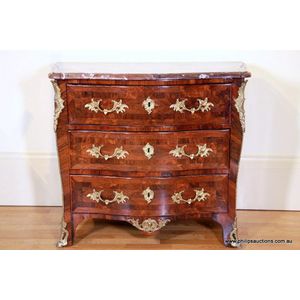Dutch Walnut Bombe Bureau with Secret Interior
You must be a subscriber, and be logged in to view price and dealer details.
Subscribe Now to view actual auction price for this item
When you subscribe, you have the option of setting the currency in which to display prices to $Au, $US, $NZ or Stg.
- Bombe Front - More commonly associated with a dome shaped dessert, "bombe" in furniture parlance means "puffed out". In profile the piece is serpentine shaped, narrow at the top, swelling out towards the middle and continuing to the floor, though sometimes it narrowed again at the foot. Drawer fronts are curved in section. Bombe pieces are often highly decorated with marquetry inlay, or veneered and set with brass or ormolu mounts. The most common use of the word, is in the description of the 'bombe commode'.
The bombe design was particularly popular in the 18th century, during the reign of Louis XIV, when it was used to create furniture pieces with a curved, rounded bulging shape. This design was used on furniture in many styles, including Baroque, Louis XIV, Louis XV and Louis XVI. The bombe chest is one of the most iconic furniture piece featuring this design. They were usually made of precious woods like mahogany, rosewood, and walnut, and feature elaborate inlay, gilded ornaments and ormolu. Other items of furniture where the bombe design can be seen include cabinets, commodes, and desks. - Ball and Claw Feet - Are in the shape of a rounded ball, attached to the underside of the carcase by a wooden shank. Introduced during the late 17th century and found on furniture in the William and Mary and Queen Anne style, are commonly found on cabriole legs in the manner of Thomas Chippendale, and furniture imitating the mid-18th century Rococo style. The leg terminates in a ball held by a carved lion's or bird's claw.
- Claw Feet - Carved or cast in the shape of a lion's claw or the talons of other more fabulous beasts. They may be found on chair and table legs, supporting platform bases, and cabinets in the Classical Revival manner. Claw feet are not uncommon on Australian furniture made throughout the 1850s and 1860s, though, as with all forms of carving, the deeper and richer the claws are carved, the earlier the piece is likely to be.
- Fall Front - Furniture with a hinged flap, usually associated with desks and secretaires, that opens or 'falls' to provide a flat writing surface. The flap may be supported by chains or brass quadrants and rest on wooden supports or runners, known as lopers, that pull out from a recess in either side of the piece. The interior of a fall-front desk is usually fitted with small drawers and pigeonholes.
This item has been included into following indexes:
Visually similar items

A Continental bombe fall-front bureau, the interior with small fitted drawers, sliding well and open stationery compartments, the base with three full width drawers and large ball and claw feet. Ornate brass back plates to handles, walnut veneer requires s

A Louis XV palisander commode, 18th century, with a rouge de Languedoc serpentine marble top above three drawers of conforming profile decorated with broad feather and crossbanded veneers utilising the vigorous figuration of the timber, a shaped apron and

Dutch walnut drop front bureau chest of drawers, 18th/19th century. 100 cm high, 75 cm wide, 48 cm deep.

A brass mounted bombe bureau, Dutch late 18th century, 100 cm high, 94 cm wide, 47 cm deep
